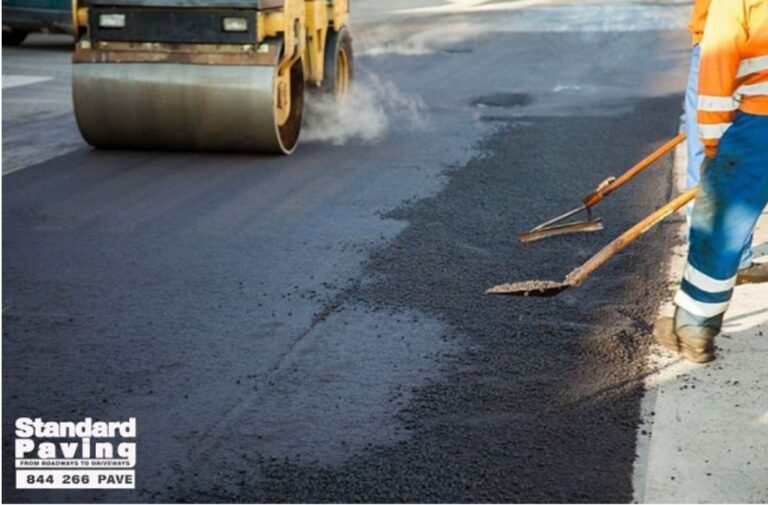Winter is the most beautiful season to enjoy, but it can also bring many challenges. Everything needs extra care and protection in the winter season, even our asphalt paving. Protecting your asphalt pavement during winter is essential to keeping it in good shape and avoiding costly repairs.
You can get the help of asphalt driveway contractors to do this care for you or pay some attention by yourself. Here are some straightforward tips to help you maintain your asphalt driveway or parking lot throughout the winter months:
Clear Debris Before Snowfall
Before winter sets in, cleaning your asphalt surface thoroughly is crucial. Remove any debris, such as leaves, dirt, and gravel. Why is this important? Debris can hide cracks and potholes, making it harder to spot areas that need repairs. Additionally, when snow falls, debris can freeze into the pavement, potentially causing damage over the winter.
Clearing debris also ensures that snow removal efforts are more effective. If debris is left on the asphalt, snowplows can push it around, potentially damaging the surface or leaving it uneven. Therefore, a clean surface looks better and sets the stage for effective winter maintenance.
Fill Cracks and Sealcoat
Inspect your asphalt for any cracks or fissures before winter arrives. Cracks in asphalt can worsen during winter due to the freeze-thaw cycle. When water seeps into cracks and freezes, it expands, causing the cracks to widen. This can lead to more extensive damage over time.
To prevent this, fill cracks with asphalt crack filler or patching material. These products seal the cracks, preventing water from penetrating further into the pavement. Consider patching with a cold mix asphalt for larger cracks or areas that have already deteriorated. Cold mix asphalt doesn’t require heating and remains flexible, which helps it to move and adapt to the pavement as it expands and contracts in freezing temperatures.
Sealcoating your asphalt before winter is also beneficial. Sealcoating provides a protective layer over the asphalt surface, shielding it from water, chemicals, and UV rays. It helps to extend the life of your asphalt and prevents oxidation, which can weaken the pavement over time.
Watch for Pooling Water
Pooling water is a common issue on asphalt surfaces during winter. When the snow melts, or rain falls, water can collect in low-lying areas or spots where the pavement has settled or developed depressions. This standing water can seep into the asphalt, leading to deterioration and potentially causing potholes.
To prevent this, pay attention to areas where water pools on your asphalt. Consider making adjustments to the pavement to improve drainage, such as filling in depressions or regrading the surface to promote water runoff. Addressing these issues before winter sets in can help minimize the risk of damage from pooling water.
Shovel Regularly
Snow removal is crucial for maintaining your asphalt pavement during winter. Snow left on the pavement can melt and refreeze, creating ice patches that are not only hazardous but can also damage the asphalt surface. Shoveling snow promptly after each snowfall helps to prevent these issues.
Use a shovel or a blower to clear snow from your driveway or parking lot. Be thoroughly removing snow from the entire surface, including edges and corners. Avoid using metal shovels or tools that could scratch or gouge the asphalt. Adjust the blade height to avoid damaging the pavement if using a snowplow.
Use Salt Wisely
Salt and other deicers are commonly used to melt ice and snow on asphalt surfaces. While effective, excessive salt use can have detrimental effects on asphalt and the environment. Salt can corrode asphalt, causing it to deteriorate over time. Additionally, salt runoff can harm plants, animals, and waterways.
To minimize these impacts, use salt sparingly and only when necessary. Clear snow and ice mechanically, using shovels or snowplows, before applying salt. Use salt according to manufacturer recommendations and avoid using more than needed. Alternative deicing agents less harmful to asphalt and the environment, such as calcium magnesium acetate (CMA) or potassium acetate, should be considered.
Repair Potholes
Potholes are common on asphalt surfaces, especially during and after winter. They form when water seeps into cracks in the pavement, freezes, and expands, causing the asphalt to break apart. Potholes not only detract from the appearance of your pavement but can also pose safety hazards to vehicles and pedestrians.
Properly repairing potholes is essential to prevent them from worsening. In winter, temporary cold patch asphalt can fill potholes until more permanent repairs can be made in warmer weather. Cold patch asphalt is designed to withstand cold temperatures and adhere to the surrounding pavement, providing a temporary fix until spring arrives.
Final Wording
Following these simple tips, you can protect your asphalt pavement from the harsh effects of winter weather and ensure it remains in good condition year-round. Regular maintenance and proactive measures can help extend the lifespan of your asphalt and save you money on repairs in the long run. If things are complex and you can’t take care of them, get the help of Paving Companies in Northern Virginia to make this work easy for you.
Read more…
